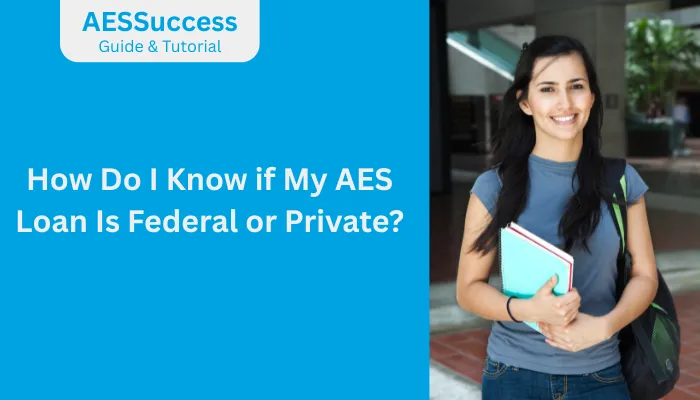When I first tackled my student loans, figuring out whether they were federal or private felt like solving a puzzle. I remember the confusion of dealing with American Education Services (AES) through their AESsuccess platform and wondering about the nature of my loans.
This question, “How do I know if my AES loan is federal or private?” is crucial because it shapes your repayment options. In this guide, I’ll walk you through my process of identifying whether your AES loan is federal or private, using clear steps, tools, and tips to make it simple and stress-free.

Why Knowing Your Loan Type Matters?
Understanding whether your AES loan is federal or private is the foundation of smart repayment planning. I learned this the hard way when I missed out on federal benefits because I didn’t know my loan type. Let me break down why this distinction is so important.
Federal loans come with protections like income-driven repayment plans and forgiveness programs, while private loans often have stricter terms. Knowing your loan type helps you access the right options. By identifying your loan type, you can strategize effectively. Let’s explore how to confirm this.
- Federal loans offer benefits like loan forgiveness, deferment, and forbearance.
- Private loans may have higher interest rates and fewer flexible repayment options.
- Your loan type affects eligibility for programs like Public Service Loan Forgiveness.
Now that you see why it’s critical, let’s dive into the steps to figure out your loan type.
Step-by-Step Guide to Identify Your AES Loan Type
I’ve been through this process myself, and I found that a clear, systematic approach makes it easier to determine your loan type. Follow these steps to find out “How do I know if my AES loan is federal or private?“.
Check the Federal Student Aid Website
The first thing I did was visit the Federal Student Aid website. It’s the most reliable way to see if your AES loan is federal.
- Go to studentaid.gov and log in with your FSA ID. If you don’t have one, create it using your Social Security number and email.
- Navigate to the “My Aid” section to view all your federal loans.
- Look for your AES loan in the list. If it’s there, it’s federal. If not, it’s likely private.
If your loan doesn’t appear, don’t panic—it’s probably private, but we’ll confirm later. This step is quick and definitive for federal loans.
Review Your Loan Documents
When I wasn’t sure about my loan status, I dug into my paperwork. Your loan documents hold key clues about whether your AES loan is federal or private.
- Check your promissory note or loan agreement for terms like “Direct Loan,” “Stafford,” or “FFELP” (indicating federal loans).
- Look for lender names. If it’s a bank or private institution (e.g., National Collegiate Trust), it’s private.
- Federal loans often mention the U.S. Department of Education as the lender.
I found my documents in my AESsuccess account or old emails from when I took out the loan. If you can’t find yours, contact AES at 800-233-0557.
Check Your Credit Report
I also pulled my credit report to cross-check my loan details. This is a great backup to confirm your loan type.
- Visit AnnualCreditReport.com to get a free copy of your credit report.
- Look for your AES loan under the lender’s name.
- If the lender is the U.S. Department of Education, it’s federal. If it’s a bank or private entity, it’s private.
This step helped me spot a private loan that wasn’t on studentaid.gov. It’s a simple way to double-check.
Understand FFELP Loans
One tricky part I encountered was Federal Family Education Loan Program (FFELP) loans. AES services these, and they’re federal but can seem private because private lenders issued them before 2010.
- FFELP loans are federal but were funded by banks and guaranteed by the government.
- They appear on studentaid.gov but may list a private lender like SunTrust.
- If your payments paused during the COVID-19 freeze (2020–2023), it’s likely a federally held FFELP loan.
Wondering “How do I know if my AES loan is federal or private?” If it’s an FFELP loan, it’s federal, but check studentaid.gov to confirm ownership.
Contact AES Directly
When I was still unsure, I called AES. They can clarify your loan type if you provide your account details.
- Call AES at 800-233-0557 or log into AESsuccess.org.
- Ask, “Is my loan federal or private?” and provide your account number.
- Request details about the lender and loan program (e.g., FFELP or private).
I found AES reps helpful, though you may need to be persistent. This direct approach clears up any confusion.
These steps gave me clarity, and they’ll work for you too. Let’s look at the differences between federal and private loans to understand your options better.
Federal vs. Private AES Loans: Key Differences
Once I knew my loan type, I could plan my repayment. So, “How do I know if my AES loan is federal or private?” The distinctions below helped me strategize.
| Feature | Federal Loans | Private Loans |
|---|---|---|
| Interest Rates | Fixed, set by Congress | Variable or fixed, set by lender |
| Repayment Plans | Income-driven, forgiveness options | Limited, lender-specific plans |
| Deferment/Forbearance | Available for hardship, school, or military | Limited, depends on lender |
| Forgiveness Programs | Eligible for PSLF, Teacher Loan Forgiveness | Not eligible |
| COVID-19 Pause | Payments paused (2020–2023) for federally held | Payments required |
- Federal loans offered me flexibility, like lowering payments based on income.
- Private loans had stricter terms, pushing me to refinance for better rates.
Understanding these differences helped me decide whether to pursue forgiveness or refinance. Now, let’s explore your options based on your loan type.
What to Do After Identifying Your Loan Type?
After figuring out my loan type, I took action based on whether it was federal or private. Once you know, here’s what to do.
If Your Loan Is Federal
Federal loans gave me access to programs that eased my repayment burden.
- Explore Income-Driven Repayment: I used the Loan Simulator on studentaid.gov to estimate payments based on my income.
- Check Forgiveness Eligibility: I looked into Public Service Loan Forgiveness if I worked in a qualifying job.
- Consider Consolidation: Combining federal loans into a Direct Consolidation Loan simplified my payments.
These options saved me money and stress. Check AESsuccess.org for tools to apply.
If Your Loan Is Private
Private loans were trickier, but I found ways to manage them.
- Refinance for Better Rates: I shopped around for lenders offering lower interest rates to reduce my payments.
- Negotiate with AES: I asked AES about temporary interest rate reductions or payment plans.
- Explore Hardship Options: Some private lenders offer limited deferment—check with AES.
Refinancing worked for me, but it’s riskier for federal loans since you lose benefits. Always weigh your options carefully. By following these steps, I took control of my loans, and you can too. Let’s wrap up with final thoughts.
Conclusion
Figuring out whether my AES loan was federal or private was a game-changer for my repayment strategy. How do I know if my AES loan is federal or private? I used studentaid.gov, checked my documents, and contacted AES to confirm.
Knowing your loan type unlocks the right repayment and forgiveness options. Start with these steps, stay organized, and don’t hesitate to reach out to AESsuccess for help. You’ve got this—take charge of your loans and pave the way to financial freedom with confidence.
